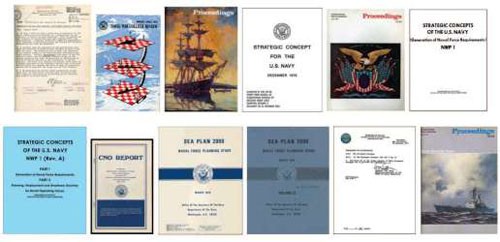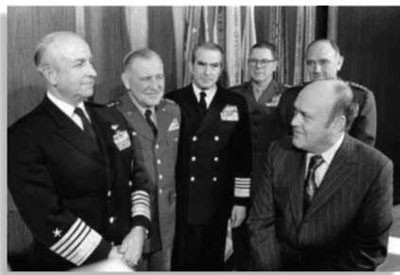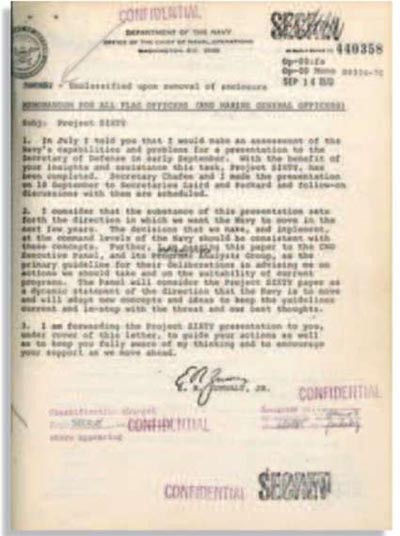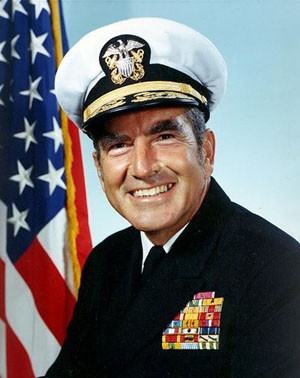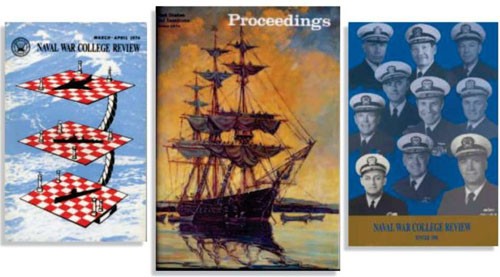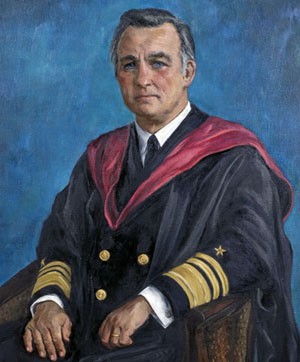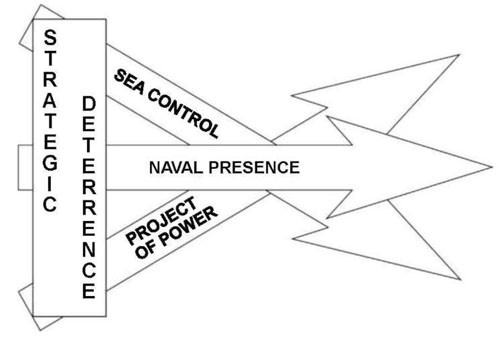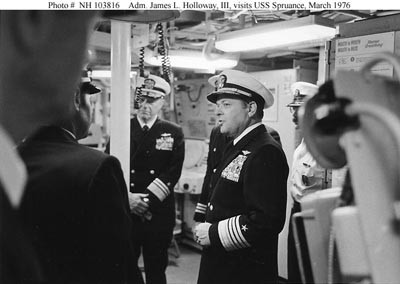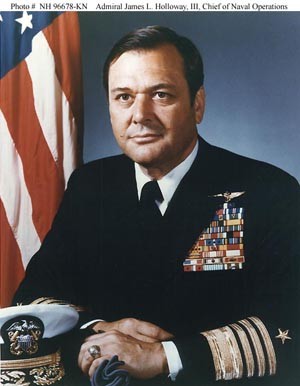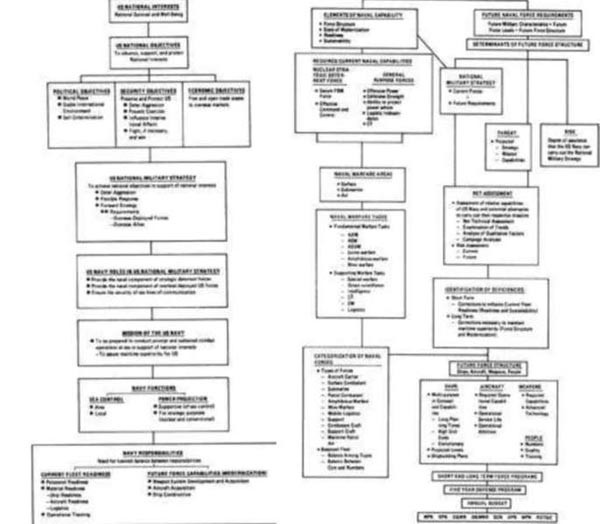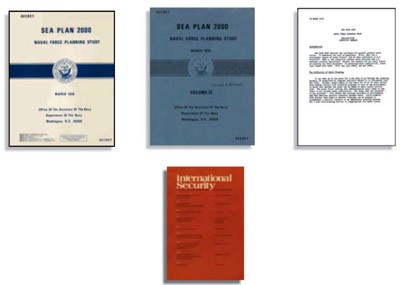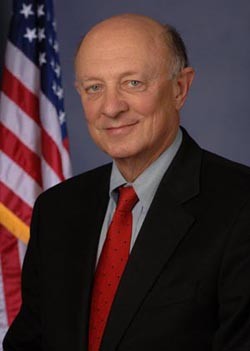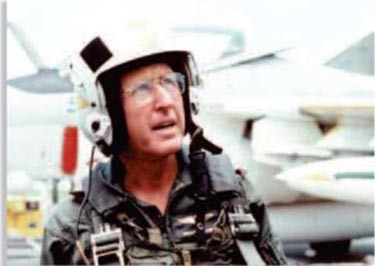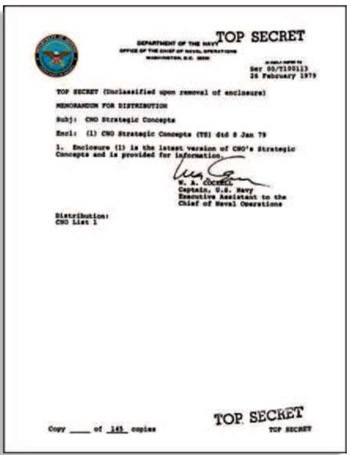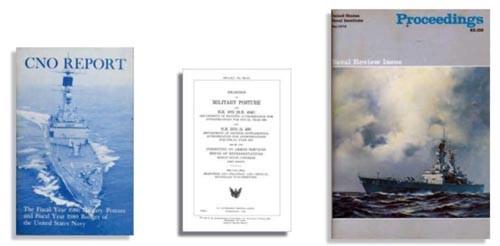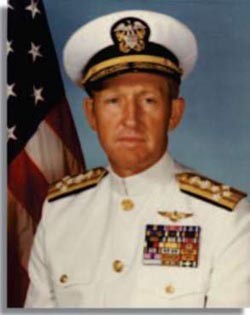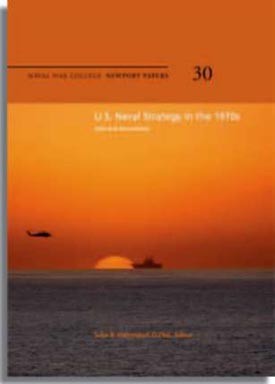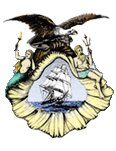
The Navy Department Library
US Navy Capstone Strategies and Concepts (1970-1980)
Strategy, Policy, Concept and Vision Documents
Peter M. Swartz with Karin Duggan
MISC D0026414.A1/Final December 2011
CNA
ANALYSIS & SOLUTIONS
CNA is a not-for-profit organization whose professional staff of over 700 provides in-depth analysis and results-oriented solutions to help government leaders choose the best courses of action. Founded in 1942, CNA operates the Institute for Public Research and the Center for Naval Analyses, the federally funded research and development center (FFRDC) of the U.S. Navy and Marine Corps.
CNA Strategic Studies (CSS), created in 2000, conducts high-quality research on and analysis of issues of strategic, regional, and policy importance. CSS' analyses are based on objective, rigorous examination and do not simply echo conventional wisdom. CSS provides analytic support to U.S. Government organizations and the governments of partner countries. CSS also maintains notable foundation-sponsored and self-initiated research programs. CSS includes a Strategic Initiatives Group, an International Affairs Group, and a Center for Stability and Development.
The Strategic Initiatives Group (SIG) looks at issues of U.S. national security, and military strategy, policy and operations, with a particular focus on maritime and naval aspects. SIG employs experts in historical analyses, futures planning, and long-term trend analysis based on scenario planning, to help key decision makers plan for the future. SIG specialties also include issues related to regional and global proliferation, deterrence theory, threat mitigation, and strategic planning for combating threats from weapons of mass destruction.
The Strategic Studies Division is led by Vice President and Director Dr. Eric V. Thompson, who is available at 703-824-2243 and on e-mail at thompsoe@cna.org. The executive assistant to the Vice President and Director is Ms. Rebecca Martin, at 703-824-2604.
The principal author of this study thanks especially Karin Duggan for graphic assistance; Loretta Ebner for administrative assistance; Gregory Kaminski, Laurie Ann Lakatosh, and Rhea Stone for library assistance; and Dana Smith and Anwar Fry for production assistance. A full listing of substantive contributors can be found in Peter M. Swartz and Karin Duggan, U.S. Navy Capstone Strategies and Concepts: Introduction and Background: Volume I, (D0026421.A1, December 2011). A full listing of all volumes in the CNA Navy Strategy series can be found on the inside back cover of this document.
Approved for distribution: December 2011
This document represents the best opinion of the author at the time of issue. It does not necessarily represent the opinion of the Department of the Navy.
Approved for public release. Distribution unlimited.
Copies of this document can be obtained through the Defense Technical Information Center at www.dtic.mil or contact CNA Document Control and Distribution Section at 703-824-2123.
Copyright 2012 CNA
This work was created in the performance of Federal Government Contract Number N00014-11-D-0323. Any copyright in this work is subject to the Government's Unlimited Rights license as defined in DFARS 252.227-7013 and/or DFARS 252.227-7014. The reproduction of this work for commercial purposes is strictly prohibited. Nongovernmental users may copy and distribute this document in any medium, either commercially or noncommercially, provided that this copyright notice is reproduced in all copies. Nongovernmental users may not use technical measures to obstruct or control the reading or further copying of the copies they make or distribute. Nongovernmental users may not accept compensation of any manner in exchange for copies. All other rights reserved.
Dr. W. Eugene Cobble, Jr. Director, Strategic Initiatives Group
Contents
| CNO Admiral Elmo Zumwalt (1970-1974) | 1 |
| Project SIXTY | 4 |
| Missions of the U.S. Navy | 17 |
| CNO Admiral James Holloway (1974-1978) | 32 |
| Strategic Concept for the U. S. Navy | 34 |
| NWP 1: Strategic Concepts of the U.S. Navy | |
| NWP 1: Strategic Concepts of the U.S. Navy (Rev A.) | |
| Sea Plan 2000 | 54 |
| CNO Admiral Thomas Hayward (1978-1982) | 72 |
| CNO Strategic Concepts | 74 |
| The Future of U. S. Sea Power | |
| Companion reference on USN 1970s documents | 90 |
Admiral Elmo Zumwalt (1970-1974)
Sep 1970 Project SIXTY
An assessment; direction to move
Mar-Apr 1974 "Missions of the Navy"
Missions
--1--
Surface warfare officer
Followed 3 naval aviator CNOs
Served under President Nixon; SECDEFs Laird, Richardson, Schlesinger; SECNAVs Chaffee, Warner, Middendorf
Drew on previous education & experience
Naval War College & National War College graduate
OSD/ISA (Arms Control), SECNAV EA, 1st OP-96 (Director, Systems Analysis)
Protege of Paul Nitze (NSC-68 Cold War strategy author)
Drew on ideas of subordinates (esp. RADM -later ADM - Stansfield Turner) & civilians (created CNO Executive Panel)
--2--
Came into office from Commander, US Naval Forces Vietnam (COMNAVFORV.
Imaginative COIN thinker & operator in-country
But saw Vietnam War as ill-advised drain on needed USN anti-Soviet resources, esp. for sea control
Had a clear agenda when he came into office and immediately created a capstone document as blueprint
Sought to implement it throughout his term
Had NAVWARCOL President VADM Turner promulgate its overarching themes at end of his term
Centralized Navy POM & budget decision-making
Publicly fearful of Soviet Navy
Sought to avoid USN anti-Soviet SSBN prosecution; focus on SLOC sea control
Opposed to Nixon-Kissinger arms control efforts (SALT I)
Conflicts with ADM Rickover
Signature programs: FFGs, PHMs, sea control ships, equal opportunity, personnel reforms
Later, continued to write on US naval policy and strategy
--3--
Memoirs:
On Watch (1976)
My Father, My Son (1986)
--4--
Overview
Signed by CNO ADM Zumwalt (Sept 1970)
"Assessment" & "Direction to Move"
Medium-length (30 pp) SECRET brief & memo
CNO flag officer special assistants drafted
Principal targets: SECDEF, OSD, DON, OPNAV Comprehensive plan, program guidance for Zumwalt term
Precedent for subsequent annual CNO program guidance
To re-optimize USN to counter Soviet threat
4 USN capability categories; hi-low mix
Sea control priority over power projection programs
Listed 22 specific actions taken or proposed
Presented 3 force structure alternatives
Concepts proved more influential than programs
Signed by:
CNO ADM Elmo R. Zumwalt, Jr.
2 months after taking office
--5--
What it was
Billed as "an assessment," "direction to move," "concepts"
Secret briefing for SECDEF Laird & DEPSECDEF (Sep 1970)
Secret memorandum to all Flag Officers (and Marine general officers)
Medium-length (30 pages plus slides)
Kickoff for development of POM-73 & precedent for subsequent CNO ADM Zumwalt annual Navy program guidance
Why it was written (I)
Show USN relevance to conflict with Soviets, primarily through SLOC defense
Re-optimize USN vs. growing Soviet at-sea combat & SLOC-cutting capabilities in a NATO-Pact war
Take advantage of SECDEF Laird de-centralization of DOD POM & budget processes to services
Establish CNO guidance as authoritative interpretation of SECDEF guidance
Centralize under the CNO what had been a decentralized internal Navy program planning process, to implement his policies
To guide USN, USMC flag/general officer actions, especially in developing POM-73 and subsequent CNO ADM Zumwalt POMs
Principal targets: SECDEF, OSD, DON, OPNAV
--6--
Why it was written (II)
Gain OSD & OPNAV support for CNO ADM Zumwalt vision to reconfigure fleet capabilities
Focus more on sea control, less on power projection
Add "low-mix" ships to established "high-mix" programs
Focus on "capability categories," to reduce "union" parochialism
Show that the Navy was conforming to:
New national "Nixon Doctrine" policy of reliance on allies, focus on USSR
Sharply reduced budget allocations
Leave the 1960s and the Vietnam War behind
Despite current ongoing major Navy Vietnam War combat operations
Context (I)
2nd year of Nixon administration (1969-74)
SECDEF Laird (1969-73)
Decentralization of DOD PPBS to services
US-Soviet strategic nuclear weapons parity
Detente, deterrence & disarmament policies vis-a-vis Soviets
Nixon Doctrine: Allies do more<> "1 1.2 War" national defense planning construct (reduced from "2 1/2 wars")
Vietnam War still raging, but US withdrawing troops
Improving US relations with China
US economy in recession
GDP growth slowing; inflation rate rising
Modest U.S. government deficit spending
Price of oil low and steady
--7--
Context (II)
AVF impending
USN downsizing; declining budgets
But, DoN TOA now >DoA or DoAF
SECNAV Chaffee (1969-72) (Made VADM Zumwalt CNO)
New CNO ADM Zumwalt (1970-74)
Soviet naval buildup
1st Soviet global naval exercise: Okean 70
Imminent deployment of Delta SSBNs w/ long range SLBMs, & Backfire-C bombers
Six-Day War Egypt Styx anti-ship missile use shock (1967)
N. Korean USN EC-121 SOJ shoot-down (Apr 1969)
Violent Sino-Soviet border clashes & nuclear threats (1969)
US withdrew from Libya Wheelus AFB (1970)
Context (III)
USN in 1970: 769 battle force ships & declining sharply; 10 new ships authorized
DON budgets declining CEP, OPNAV OP-00K, NADEC created (1970)
Demise of OPNAV Long Range Planning Group (1970)
Carriers changing to CV/CVN concept
From CVAs & CVSs
--8--
Cited references
Nixon Doctrine (1969)
JCS Plans
DoD FY 72 Fiscal Guidance
FY 72 POM Annex Navy budget
Context: Other important publications
CAPT E.R. Zumwalt, Jr., "A Course for Destroyers," US Naval Institute Proceedings (Nov 1962)
NATO MC 14/3 Overall Strategic Concept for the Defense of the NATO Area (1968)
Flexible response
NATO MC 48/3 Measures to Implement the Strategic Concept for the Defense of the NATO Area (1969)
SACLANT, Relative Maritime Strategies and Capabilities of NATO and the Soviet Bloc ("Brosio Study") (Mar 1969)
DOD Dir 5100.1 Functions of the Armed Forces and the Joint Chiefs of Staff (31 Dec 1958)
Herman Kahn works
Robert Herrick, Soviet Naval Strategy (1968) (resisted)
Paul Nitze thinking
Naval Warfare NWP 10B (1970)
--9--
How it was written
Drafted by RADM-SEL Stansfield Turner
New OPNAV special office (Op-OOH)
Drew officers from OP-60, OP-93, OP-96, Secretariat
Finished by RADM Worth Bagley
"60-day effort"
CNO & SECNAV Chaffee briefed SECDEF Laird & DEPSECDEF Packard, to influence POM 73 (Sep 1970)
Then distributed to USN, USMC flag & general officers
Tracking goal accomplishment (measuring effectiveness) by new Coordinator of Decisions (OP-09C) (RADM Emmett Tidd)
Outline
CNO's Project SIXTY presentation to SECDEF
Assured second strike potential
Sea control and projection
Overseas presence
Alternative combinations of sea control and projection forces
Other types of change
Summary
--10--
Key Ideas (I):
Soviets & their navy are the priority threat
Taken very seriously
"CHICOM" threat mentioned in passing
Soviet threat is global
Alarming view of USN capabilities to defeat Soviets at sea
55% w/ present forces
30% w/ POM 72 forces
Vital importance of NATO flanks & NE Pacific
Joint & allied coordination & cooperation
Need allied navies to contribute more to sea control
Reprioritized naval missions
Key ideas (II):
22 specific actions taken or proposed
Included topics for further study & analysis
3 force structure alternatives
Theater tradeoffs necessary. Gave details.
Retire obsolescing forces early (for $)
Modernize ("hi-low mix")
New R&D initiatives
Reduce support costs
Pursue people programs
Reduce forward deployments to ensure optimum rotation policies for personnel retention & motivation
Testing new force packages: Add SSNs to surface task forces
--11--
What was new?
Comprehensive USN statement of strategy & policy
Annual CNO program guidance
4 prioritized disaggregated capabilities
Assured second strike
Control of sea lines and areas
Projection of power ashore
Overseas presence in peacetime
"Strategic deterrence must come first"
Focus on sea control vs. Soviet threat
Shift $ from VN-era USN power projection CV strike to defensive sea control
Many new programs
Sea control ships to replace CVSs (aborted)
Perry-class FFGs
Tracking goal accomplishment; measuring effectiveness
Not addressed
Naval Warfare NWP 10B (1970)
Non-Soviet threats
World trade issues
On-going war in Vietnam
USN submarine ISR operations
Counterinsurgency; terrorist threats
Coastal & riverine operations & programs
Humanitarian Assistance/Disaster Response
Maritime Security Operations
US Coast Guard
US government inter-agency partners
US industrial base & shipbuilding
Little on USMC
Just distribution list & USMC CV TACAIR bid
--12--
Subsequent analyses & critiques
Herschel Kanter & Thomas Anger, Navy Responses to Changes in the Defense Resource Planning Process (CNA 1973)
ADM E.R. Zumwalt, Jr., On Watch (1976)
David A. Rosenberg, "Project 60: Twelve Years Later" (1982)
Jeffrey Sands, On His Watch (CNA 1993)
Included measuring effectiveness
Norman Friedman, Seapower and Space (Ch X) (2000)
CAPT Terry Pierce, Warfighting and Disruptive Technologies (2004)
Edgar Puryear, American Admiralship (Ch IX) (2005)
Harlan Ullman, "A New Maritime Strategy," US Naval Institute Proceedings (Mar 2007)
Criticisms (I)
"A non-Mahanian aberration" (Norman Friedman)
Too defensive and fearful
Too much focus on sea control vs. Soviets
Too little focus on power projection vs. Soviets
Sea control & power projection were actually intertwined, not bifurcated
Wrongly assumed Soviet priority to cut SLOCs
To abandon naval offensive would lose the fleet & the war
--13--
Criticisms (II):
A step backwards from focus on forward USN influence on events ashore
Wrong solutions to problems
Unaffordable
Led to tactical caution
Not well connected to national policy of detente
Not joint or allied enough
Too parochial (surface-warfare advocacy)
Too heavy on programmatics and too light on strategy
Not a consensual document. One man's vision
Influence (I):
Wide within Navy & DOD at the time
Led to increased DOTMLPF focus on sea control
Concepts more influential than specific programs
Many programs repudiated by successors
Subsequent Navy program planning used Project 60 "missions of the Navy" construct: Strategic deterrence, projection of power, control of sea lines
Especially OP-96-led CNO Program Analysis Memoranda (CPAMs)
OP-96 reorganized internally along "mission area" & "support area" lines
Overseas presence could not be used to justify forces, IAWDOD guidance
--14--
Influence (II):
Institutionalized as annual CNO Policy and Planning Guidance (CPPG) (from 1971 on)
Drafted in OP-96 (Systems Analysis) (RADM Turner (1971-2) et al.)
As a Navy "program planning" document, OP-00H-drafted Project SIXTY & successor OP-96-drafted CPPGs eclipsed influence of OP-06/OP-60-drafted planning & strategy documents as conceptual basis for internal OPNAV & USN thinking during 1970s
Led to USN emphasis on "second P" of PPBS, vice "First P"
Why did it have this influence (I)
Personalities:
Strong backing by forceful & thoughtful, but unorthodox & controversial, CNO ADM Zumwalt
Continued advocacy by Stansfield Turner
As RADM & OP-96 (1971-2); and later VADM & President, Naval War College (1972-4)
Effective CNO management techniques (special assistants, NADEC, Z-Grams, successor CPPGs)
Deliberate fostering of OP-96-led OPNAV "program planning" as intellectual center of OPNAV staff, vice OP-06-led "planning"
--15--
Why did it have this influence (II)
SECDEF Laird left Navy alone to implement its own plan
Declining US defense budgets & post-Vietnam operational lull in 1970s led to USN focus on getting the budget right
Limited internal Navy buy-in on many specifics
Crystallized poles in USN thinking; sparked debates
1982 ENS Rosenberg OP-965 retrospective study showed utility of comprehensive USN policy statement
Successive descendent CPPGs had become more programmatic & less conceptual & strategic overtime
Influence on subsequent capstone documents
Set the example for all
Conceptual roots of Missions of the U.S. Navy
Triggered contrary views in Strategic Concepts of the US Navy
Studied for lessons leading to The Maritime Strategy
But spawned succession of CPPGs that refocused many in Navy away from strategy
--16--
Overview
Drafted & signed by NAVWARCOL President VADM Turner (Mar-Apr 1974)
Drafting assistance by NAVWARCOL faculty
Short (16 pp max) UNCLAS articles
Described 4 Navy missions (from Project SIXTY)
Showed relationship of missions to tactics
Deliberate creation of a new vocabulary
Principal target: US Navy officer corps
USN officers should think deeply about their service
Missions construct lends itself to analyzing naval issues
Soviet Union the chief threat for USN to counter
Lasting influence
--17--
Signed by VADM Stansfield Turner
President, Naval War College (1972-4)
Surface warfare officer
Later, NATO CINCSOUTH, Carter Administration CIA Director (1977-81)
Continued to write extensively on naval policy & strategy
What it was
Billed as "Missions"
UNCLAS Naval War College Review article (Mar-Apr 1974)
Short (16 pages)
Reprinted in Naval War College Review (Winter 1998)
UNCLAS US Naval Institute Proceedings article (Dec 1974)
Derived from Project SIXTY
--18--
Why it was written
To get USN officers to think deeply about their service
To transform Navy internal thinking about what it does
To help naval officers understand what is best for the whole organization, not just their own platforms or programs
To focus the Navy on cross-cutting outputs (missions), vice parochial inputs (platforms, unions)
To inform future naval force structure decisions
To form a basis to establishing priorities for allocating resources
To assist in selecting the best among competing systems
Institutionalize Project SIXTY framework
Principal target: US Navy officer corps
Context (I)
Last year of Nixon administration (1969-74)
Watergate scandal 1972-4
All US forces withdrawn from South Vietnam (1973)
Northern combat actions against South Vietnam continued
SECDEF Schlesinger (1973-75)
All-Volunteer Force (from 1973)
US economy in recession again; inflation rate rising
Arab oil embargo; Price of oil soaring
--19--
Context (II)
SECDEF nuclear strategy changes (1974)
Palestinian attack at Munich airport (1970). Beginning of major terrorist campaign
Munich Olympics (1972); Rome airport (1973)
World food crisis (1972-74)
Shortages, price hikes led to famines, unrest
Yom Kippur War (1973)
Battle of Latakia
1st naval battle in history between surface-to-surface missile-equipped boats, & using electronic deception
Context (III)
Nixon-Brezhnev Moscow summit meeting (May 1972)
High point of detente
INCSEA agreement with Soviets (1972)
ABM & SALT Treaties (1972)
Soviet naval buildup
Delta-class SSBNs w/long-range SLBMs (from 1972)
USN-Soviet Navy Mediterranean confrontations (1970 & 1973)
USN post-Vietnam War ops
Indo-Pakistani War & Enterprise cruise (1971-2)
Close Soviet-Indian military ties
Improving US relations with PRC
--20--
Context (IV)
Outgoing CNO Zumwalt (1970-74)
OPNAV reorganization: Creation of "3 platform barons" as Deputy Chiefs of Naval Operations (DCNOs) (1971)
OP-02 (Submarines); OP-03 (Surface); OP-05 (Air)
Formalized increased post-World War II officer specialization
OPNAV OP-090 Net Assessment Office created
OP-96-led "program planning" the dominant intellectual activity in OPNAV, vice OP-06-led "planning"
Declining DON budgets
USN in 1974: 512 battle force ships and declining sharply; 14 new ships authorized
But, DON TOA now DA or DAF
Context (V)
Sea Control Ship experiment on USS Guam with AV-8s & SH-3s (1972)
Racial incidents on USN ships (1972)
"Turner Revolution" at Naval War College (1972-4)
Curriculum transformation, esp. Strategy & Policy Course (1972)
New top-notch faculty, esp. Strategy Department
Current Strategy Forum instituted (1973)
Increasing USAF minelaying & surveillance support at sea
Army at TRADOC developing defensive operational doctrine focused on Europe
--21--
Context: Cited references
Mahan
Context: Other important publications
Project SIXTY (1970)
Robert Herrick, Soviet Naval Strategy (1968) (resisted)
Cable, Gunboat Diplomacy (1970)
USN-USAF MOAs on B-52 minelaying at sea (1971, 1974)
Future Maritime Strategy Study (FUMAR) (1973)
"U.S. Strategy for the Pacific/Indian Ocean Area in the 1970s"
"Project 2000" long-range planning Study (1974)
ADM Gorshkov, "Navies in War and Peace" articles in US Naval Institute Proceedings (with commentaries) (Jan-Nov 1974)
--22--
How it was written
Drafted at newly-transformed Naval War College
Drafter: NAVWARCOL President, VADM Stansfield Turner (Jun 1972-Aug 1974)
Had conceived and drafted CNO ADM Zumwalt's Project SIXTY
Director of OPNAV analysis office (OP-96) before going to NWC
Leaving Naval War College for command of US Second Fleet
Editor & sounding board: CDR George Thibault (NAVWARCOL faculty)
Outline (Naval War College Review article)
Usefulness of categorizing Navy missions
Evolution of Naval capabilities and missions
Definition of naval missions and discussion of their forces and tactics
Strategic deterrence mission
Sea control mission
Projection of power ashore missions
Naval presence mission
Current and future issues involving naval missions areas
--23--
Key ideas (I):
4 "Missions:
Naval War College Review order
Strategic deterrence
Projection of power
Sea control
Naval presence
US Naval Institute Proceedings order
"Warfighting missions" Sea control
Projection of power
"Deterrent missions"
Naval presence
Strategic deterrence
Key ideas (II):
Each of 4 missions subdivided into "tactics"
Detailed & nuanced definitions & discussions of each
--24--
Key ideas (III):
"To force the Navy to think in terms of output rather than input"
(Key goal of McNamara-instituted PPBS since 1961-2)
Missions as "outputs"
Tied to national objectives
Interdependent
NOT prioritized
Tradeoffs within/among missions
USMC implements a few of the tactics
Key ideas (IV):
USN officers should think deeply about their service
USN sea control focus may yield to naval presence focus (US Naval Institute Proceedings article)
Discussed historical development of Navy concepts
Placed 4 Missions in historical context
Soviets the chief threat
Communist Chinese threat mentioned in passing
Discussion of "blockade" as a discreet naval operation
--25--
Interdependent Naval Missions
Reproduced with permission from: Naval War College Review. Mar-Apr 1974 Vol XXVI, #5. "Missions of the U.S. Navy," by Vice Admiral Stansfield Turner, U.S. Navy, President, Naval War College.
What was new
Going public with Project SIXTY 4-capability construct
Explicit discussion of "sea control" as superseding "control of the sea" terminology
Rejection of "command of the seas" and "sea power" terminology
Explication of "Presence" mission Tying mission areas to tactics
Wide subsequent influence and citation
--26--
Not addressed (I)
Explicit priorities among missions
Non-Soviet threats
World trade issues
Submarine ISR operations
Counterinsurgency & irregular warfare
Convoy operations Coastal & riverine operations & programs
Maritime Security Operations
Terrorist threats
Humanitarian Assistance/Disaster Response
"Fleet-in-being" or "force-in-being"
Not addressed (II)
Sealift
US Coast Guard; U.S. Army
U.S. Merchant marine
US industrial base & shipbuilding
U.S. government interagency partners
Little joint or allied mention
--27--
Subsequent analyses & critiques
ADM E.R. Zumwalt, Jr., On Watch (1976)
John Allen Williams, "Strategies and Forces of the U.S. Navy: A Critical Reappraisal," Armed Forces & Society (Summer 1981)
Were they "missions?"
What is a "mission" (officially)?
1. The task, together with the purpose, that clearly indicates the action to be taken and the reason therefore. 2. In common usage, especially when applied to lower military units, a duty assigned to an individual or unit. 3. The dispatching of one or more aircraft to accomplish one particular task.
Joint Pub 1-02 DOD Dictionary of Military and Associated Terms (Oct 2008)
--28--
Were they "missions?
What is a "mission" (officially)?
"The terms 'roles, missions, and functions' often are used interchangeably, but the distinctions between them are important. 'Roles' are the broad and enduring purposes for which the Services...were established in law. "Missions" are the tasks assigned by the President or Secretary of Defense to the combatant commanders. 'Functions' are specific responsibilities assigned by the NCA to enable the services to fulfill their legally established roles."
Joint Pub 02 Unified Action Armed Forces (UNAAF) (July 2001)
Criticisms
These weren't really "missions"?
These weren't really the right missions.
"Sea control" really 2 missions: "Offensive" & "Defensive" (CDR/Dr John Allen Williams USNR)
Sea control & power projection intertwined, not bifurcated
Presence not really a "mission"
All 4 missions not co-equal
Implicit primacy of "sea control" right/wrong
New vocabulary shouldn't supersede older terms
--29--
Subsequent evolution of ADM Turner's thought
4 roles/missions of the Navy
Sea control
Projection of power by amphibious assault
Projection of power ashore by bombardment
Strategic nuclear retaliation
Today a new mission may be emerging
Defending the homeland or other land areas against attack by missiles through space
Setting aside homeland defense...The other four missions are today of lessening importance to our country's security
ADM Stansfield Turner USN (Ret)
"Is the U.S. Navy Being Marginalized?"
Naval War College Review (Summer 2003)
Influence:
Very wide and very long-lasting
In particular, led to increased DOTMLPF focus on naval forward presence
Cited throughout world defense literature
E.g.: Japanese admiral quoted in 2007 conference paper
Forged a long-lasting consensus on the missions of the US Navy
Spilled over into CNO ADM Holloway 1st (Mar 75) Posture Statement & US Naval Institute Proceedings article (Jun 1975)
--30--
Why did it have this influence?
Groundwork already laid by Project SIXTY, subsequent CPPGs, and OP-96-led OPNAV program planning
Simple, elegant construct; Filled a conceptual void & need
Widely adopted by Navy leadership
Personality: VADM Turner reputation as USN's intellectual leader, inside & outside USN
Adopted by academia (civilian & military)
Links to ADM Zumwalt-specific policies muted
Influence on subsequent capstone documents
New vocabulary used in almost all
But "control of the seas" & "Sea power" terms persisted too
4-mission framework triggered contrary views in Strategic Concepts of the US Navy & The Future of U.S. Sea Power
Missions restated, re-ordered and/or modified somewhat in Forward...From the Sea, Anytime, Anywhere, Naval Power 21, Sea Power 21, & added to in NOC (2006)
Missions repeated in 2007 Program Guide to the U.S. Navy ("crisis response" added)
Missions formed 4 of 6 "core capabilities" of Cooperative Strategy for 21st Century Seapower (2007)
--31--
Dec 1975 Strategic Concept for the U. S. Navy (S)
1976-78 CNO Reports (Posture Statements)
Jul 1976 "U.S. Navy: A Bicentennial Appraisal"
Jan 1977 Strategic Concepts of the U.S. Navy (NWP 1)
May 1978 Strategic Concepts of the U.S. Navy NWP 1 (Rev. A)
(Mar 1978) (Sea Plan 2000) (S)
A force planning study
Naval aviator (nuclear power trained & experienced)
Served under Presidents Ford & Carter; SECDEFs Schlesinger, Rumsfeld & Brown; SECNAVs Middendorf & Claytor Experienced in initiating concepts & processes
E.g.: NATOPS; USN program planning; CV concept (1968); Nuclear Powered Carrier Program; changed USN frigate nomenclature; CVBGs (1977); flexible, reconfigurable air wing; fostered CWC concept
Combat veteran of three wars & numerous crises
--32--
Initially let previous concepts stand (he had been VCNO under ADM Zumwalt)
Progressively developed & promulgated a new coherent set of concepts to replace them
At end of his term, promulgated a final comprehensive statement
His DCNO for Plans Policy & Operations, VADM William Crowe, created a new Strategy & Concepts Branch (OP-603), staffed by hand-picked strategists (1978)
Fought successfully to prevent cruise missiles from being banned by US-USSR SALT II agreement
Signature program: CVN, CVBG
Later, continued to write on naval strategy & policy, & serve on high-level national & DOD commissions & study groups
President, Council of American-Flag Ship Operators (1978-88)
Chairman, Special Operations Review Group (investigating 1980 Desert One Iran Hostages Rescue debacle)
Executive Director, President's Task Force on Combating Terrorism (1985)
President, then Chairman of Naval Historical Foundation (1980-2008)
Memoir: Aircraft Carriers at War: A Personal Retrospective of Korea, Vietnam and the Soviet Confrontation (2007)
--33--
Strategic Concepts of the U.S. Navy (1975-8)
Overview
Drafted and signed by CNO ADM Holloway
"Strategic Concepts"
Principal targets: USN officer corps & Capitol Hill
CLAS memo, then UNCLAS article, NWP, posture statement brochures, revised medium-length (37 pp) NWP
Concepts evolved through various editions
Comprehensive analysis of naval requirement development
Rigorous flow from national policy to systems
Focus on naval warfare tasks, across platforms
Highlighted range of aircraft carrier capabilities
No specific USN adversaries mentioned by name
Still modestly influential
--34--
Signed by:
CNO ADM James L. Holloway, III
Successive drafts after 1 1/2 years in office
What it was
Billed as "Strategic concept(s)"
Secret signed document circulated to Fleet
Commanders for comment (Dec 1975)
CNO Reports (Posture Statements) (Jul 76, Apr 77, Mar 78)
Pocket-sized for portability
US Naval Institute Proceedings article (Jul 1976)
UNCLAS Naval Warfare Publications (NWP)
NWP 1 (Jan 1977)
NWP 1(A) (May 1978): 37 pages
Not formally cancelled until 1993
Later boiled down in Holloway 1985 Oceanus article
--35--
Why it was written (I)
So USN officers would understand basic USN concepts, doctrine & processes, in order to be able to contribute effectively to internal Navy decisions, make effective external cases for the Navy, and understand the implications of making changes
To lay out the capabilities of the US Navy in support of the nation, including aircraft carriers
Reaction to Project SIXTY & Turner "Missions" "Consolidation" of internal USN thinking, esp. "missions"
To emphasize warfare tasks over platforms
And in so doing highlight the versatility of the aircraft carrier
Why it was written (II)
To reflect evolution of CNO ADM Holloway's thinking
To influence Administration policies:
To create a coherent Navy policy statement in anticipation of a possible Jan 1977 change in administrations (1975-6)
To try to influence new administration policies (1977)
To try to change administration policies (1978)
To enlist Congressional support in influencing/changing Administration policies (1977-8)
To achieve consensus on US Navy roles, missions, tasks, functions (and, ultimately, force levels & mix)
Principal targets: USN officer corps, Capitol Hill, DOD
--36--
Context (I)
CNO ADM Holloway (1974-78)
2nd year of Ford (R) administration (1974-77) thru 2nd year of Carter (D) administration
US voters repudiated Ford administration (Nov 1976)
SECDEFs Laird, Rumsfeld (1975-77); SECNAV Middendorf
SECDEF Brown (1977-81); SECNAV Claytor
US economy pulling out of recession (from Mar 1975)
But inflation rate rising & unemployment rate high
Increasing U.S. government deficit spending
Price of oil high but declining somewhat
PRC occupied Paracel Islands; PLAN defeated VNN in South China Sea naval battle (1974)
N. Vietnam victory, occupation of S. Vietnam (1975)
Communist regimes in Laos, Cambodia (1975)
Context (II)
National policy shift from Pacific military commitments
Outgoing Ford Administration policies comfortable for Navy, if underfunded
Soviets deployed SS-20 nuclear missiles Intermediate-Range Nuclear Forces (INF) in Central Europe (1975)
US countered with Pershing II & GLCM INF deployment plans
New Carter administration defense focus on NATO central region & USN Atlantic SLOC protection
Robert Komer as DOD Special Assistant for NATO
--37--
Context (III)
Arms Control Agreements & talks
Seabed, INCSEA, SALT I, ABM
US-Soviet talks to demilitarize Indian Ocean (1977-8 )
Soviet fleet build-up
New Delta-class SSBNs w/ long-range SLBMs (1972)
Soviet SSBNs no longer needed to deploy far forward & transit GIUK & other barriers to reach CONUS targets
Backfire-B bomber with ASMs (1972)
To keep US carrier aviation beyond striking range of Soviet targets
2nd Soviet global naval exercise: Okean 75
1st USN, Soviet Navy reciprocal port visits (1975)
Context (IV)
Increased Soviet interventions in 3rd world
Close Soviet-Indian military ties
1st nuclear weapon test by Soviet-friendly India (1974)
Improving US relations with PRC
Yom Kippur War (1973)
Battle of Latakia
1st naval battle in history between surface-to-surface missile-equipped boats, & using electronic deception
--38--
Context (V)
Portuguese empire freed (1974-5)
Periodic Korean crises
Tree-cutting incident & Operation Paul Bunyan (1976)
Panama Canal transfer treaty signed (1977)
Executive branch, Congress reluctant to intervene overseas in 3rd world ("Vietnam syndrome")
Congress blocked US aid to anti-Communist forces in civil war in newly-independent Angola (1975-6)
Context (VI)
Declining USN force levels; fluctuating DON budgets
USN in 1978: 468 battle force ships & starting to increase somewhat; 18 new ships authorized
Emerging USN force level goal: 600 ships
New systems entering fleet
CWC concept entering fleet
Internal USN "Repeal Zumwalt" debates
Bitter internal US government aircraft carrier, VSTOL budget debates
Culmination: Congress debated adding CVN 71 to carrier-less FY 79 defense budget (Feb-Aug 1978)
--39--
Context (VII)
Specialized USN ASW carriers disappeared
CVA/CVAN/CVS * CV/CVN
CVWs transformed from 2 specialized air wing types to one general multi-mission model
New fleet battle organization (1977)
CVTF/CVTG * CVBF/CVBG
Continued primacy of OP-96-led program planning as intellectual basis for OPNAV activity, vice OP-06-led planning
OPNAV Op-96-OP-60 rivalry
Context (VIII)
USN surface ship reclassifications (1975)
CNO ADM Holloway initiatives
Brought USN "frigate" nomenclature in line with international practice
Eliminated perceived USN-Soviet Navy "cruiser gap"
Eliminated USN surface combatant "escort" terminology
CG/CLG
CG
DL/DLG
CG or DDG
DD/DDG
DD/DDG
DE/DEG
FF/FFG
PF
FFG
CNO ADM Holloway decision to halt CGN procurement
--40--
Context (IX)
New SACLANT/CINCLANT/CINCLANTFLT/C2F plans to shift Atlantic convoy routes south, to free up escort forces for northern forward ops
New CINCPAC/CINCPACFLT/C7F plans for northern offensive vs. Soviets in NW Pacific
CINCUSNAVEUR/C6F plans to stand & fight in central, eastern Med
But NATO CINCSOUTH ADM Turner plans to move forces to western Med & LANT in time of crisis
Context (X)
USN Advanced Technology Panel (ATP) created (1975)
NAVWARCOL Center for Advanced Research created (1975)
John F. Lehman as CNO consultant (from 1977)
Army at TRADOC developed defensive operational doctrine focused on Europe (1976)
Increasing USAF minelaying, surveillance support at sea
Military Reform Movement (from 1976)
SEN Taft, then SEN Hart. Bill Lind
Adopted & advocated "lo" end of Zumwalt "hi-lo mix"
Committee on the Present Danger (from 1976)
Paul Nitze, John Lehman, etc.
--41--
Cited references
Title 10 of U.S. Code
DOD Dir 5100.1 Functions of the Armed Forces and the Joint Chiefs of Staff (31 Dec 1958)
DOD Total Force Policy
Unified Command Plan
JCS & USN Readiness Reporting Systems
Discussed historical development of USN strategy & law of the sea
Context: Other contemporary publications (I)
Robert Komer RAND studies on NATO (1973-6)
Esp. Alliance Defense in the Eighties (AD-80) (Nov 1976)
Collaborator: CAPT Ernie Schwab USN (Ret)
NSDM 242 Policy for Planning the Employment of Nuclear Weapons (Jan 1974) (flexible nuclear options)
NIE 11-15-74 Soviet Naval Policy and Programs (Dec 1974)
ADM Gorshkov, "Navies in War and Peace" US Naval Institute Proceedings articles (w/USN flag officer commentaries) (1974)
Bound & published as Red Star Rising at Sea (1974)
NSDM 242 Policy for Planning the Employment of Nuclear Weapons (Jan 1974) (flexible nuclear options)
OPNAV OP-96, Project 2000 (1974-1977)
USN-USAF MOA on cooperation at sea (1975)
--42--
Context: Other contemporary publications (II)
Barry Blechman, The Control of Naval Armaments: Prospects and Possibilities (1975)
CBO (Dov Zakheim) reports on USN (1975-80)
David Rosenberg & Floyd Kennedy, History of the Strategic Arms Competition, 1945-1972. Supporting Study: U.S. Aircraft Carriers in the Strategic Role, Part I - Naval Strategy in a Period of Change: Interservice Rivalry, Strategic Interaction, and the Development of Nuclear Attack Capability, 1945-1951 (Lulejian) (1975)
Record & Binkin (Brookings), Where Does the Marine Corps Go from Here? (1976)
SEN Taft "White Paper on Defense" (1976)
US Army FM 100-5 Operations ("active defense") (1976)
Context: Other contemporary publications (III)
CINCPACFLT ADM Hayward "Sea Strike" briefings (1977-9)
NSDM 344 Navy Shipbuilding Program (Jan 1977)
Lame duck Ford Admin call for 600 ships; VSTOL carriers
Based on NSC study on "U.S. Strategy and Naval Force Requirements" (Sep 1976)
John Lehman helped draft
NSC PRM 10 Military Strategy & Force Posture Review (1977) & PD 18 US National Strategy (Aug 1977)
USN Sea Based Air Platform Study (Feb 1978)
Sea Plan 2000 naval force planning study (1978)
--43--
How it was written (I)
Personality: CNO ADM Holloway the driver
Saw importance of "writing it all down", himself
Advocate of direct senior involvement; not "completed staff work"
Advocate of standardized processes throughout his career
Denigrated fancy pictures and art work
Assisted by
Executive Assistant CAPT John Poindexter as sounding board
CNO Fellow
OP-60N (LCDR Joseph Strasser, Fletcher Ph.D.); 1-on-1 meetings
CAPT Dirk Pringle (OP-64) for "readiness" section
How it was written (II)
Unhappy with "4 Missions of the Navy," (which had informed his 1st Posture Statement & 1st US Naval Institute Proceedings article)
Continuously reworked his ideas, in various media
Added "readiness" section IRT perceived SECDEF Brown confusion on readiness terminology at Armed Forces Policy Council meeting
Published in final form as NWP 1 (Rev A) in May 1978
Saw it as a baseline. Ok to deviate from as required
"If you're going to break the rules, you've got to have rules to break"
--44--
Outline (NWP 1 (Rev A)
Part I: Generation of naval force requirements
1. Introduction
2. National strategy
3. U.S. Navy support of the national military strategy
4. Required capabilities and characteristics of naval forces
5. Navy program development
Part II: Planning, employment and readiness doctrine for naval operating forces
Key ideas (I)
Strategic concepts drive force requirements
Formal orderly top-down general processes
Used accepted DOD definitions of terms
"Mission," "roles," "functions," etc.
Importance to US of open & free seaborne trade
Importance of factors unique to shipbuilding
--45--
Key ideas (II)
Utility & importance of net assessment & analysis
Importance of ship & a/c readiness & employment cycles
Forward deployment & surge posture balance
Coordinated joint & allied ops
USN sea control a prerequisite for sustained Army, Air Force overseas campaigns (enabling)
Capabilities-based. Discussed only generic threats
Soviets not mentioned
Key ideas (III)
Revised (& complexified) Turner concepts, vocabulary
2 basic USN functions
Sea control (prerequisite)
Power projection
3 USN roles
Strategic nuclear deterrence
SLOC security
Overseas deployed forces
Presence = a "clear side benefit" of forward deployment
Must reflect "combat capability"
Presence nota mission buys "reduced response time"
--46--
Key Ideas (IV)
Fundamental warfare tasks
AAW
Strike ASW
Amphibious
ASUW
Mine
Supporting warfare tasks
Special warfare
C3
Ocean surveillance
EW
Intelligence
Logistics
NWP 10(B) (1970)
"Types of naval operations"
Strike force operations
Amphibious operations
Anti-air warfare
Anti-submarine warfare
Mining & mine countermeasures
Riverine operations
Support operations
Surveillance & blockading
Search and rescue
Domestic emergency operations
NWP 1 (Rev A) (1978)
"Warfare tasks"
Anti-air warfare
Anti-submarine warfare
Anti-surface warfare
Strike warfare
Amphibious warfare
Mine warfare
Special warfare
Ocean surveillance
Intelligence
C3
Electronic warfare
Logistics
--47--
Key ideas (V)
Warfare tasks across platforms
Update of earlier NWP 10 listings
Implicit primacy of strike warfare & carrier platform
New CVBG force packages to incorporate CVS missions
USMC = 1/2 of 1 of 6 "fundamental" warfare tasks
Key ideas (VI): Evolution of CNO ADM Holloway thinking
1975 Posture Statement & NIP article
Followed Zumwalt-Turner "4 Missions" construct
Dec 1975 SECRET Strategic Concept for the U.S. Navy
"Sea Control is the fundamental U.S. Navy function"
Naval presence a "unique capability"
1976 Posture Statement & July 1976 US Naval Institute Proceedings article
Two principal functions: Sea Control & Power Projection
1977 & 1978 Posture Statements
May 1978 NWP 1 (Rev A)
Naval presence a "clear side benefit"
--48--
Generation of A Naval Force Requirements
What was new (I)
Heavy CNO involvement in initial drafting
CNO signature
Contrast with Naval Warfare (NWP 10) of 1950s & 60s
Comprehensive taxonomies & processes
Even submarine reconnaissance role embedded in chart
--49--
What was new? (II)
Capabilities-based threats
No mention of Soviets
Contrast with ADMs Zumwalt & Turner's approach
Mention of benefits to US of "a system of free & open trade"
Reference to a "system" will not reappear for 20+ years
NWP-Posture Statement similarity
Not addressed
Soviets (or any other adversary) by name
Terrorist threats
Humanitarian Assistance/Disaster Response
Maritime Security Operations
US Coast Guard
Arms control
U.S. government interagency partners
Blockade
--50--
Barely addressed
"Sealift" mentioned as part of "logistics" task
Unconventional warfare, coastal & riverine interdiction subsumed under Naval Special Warfare
Were they "strategic concepts?"
What is a "strategic concept" (officially)?
The course of action accepted as the result of the estimate of the strategic situation. It is a statement of what is to be done in broad terms sufficiently flexible to permit its use in framing the military, diplomatic, economic, informational, and other measures which stem from it
Joint Pub 1-02 DOD Dictionary of Military and Associated Terms (Oct 2008)
--51--
Subsequent analyses & critiques
ADM James L. Holloway III, Aircraft Carriers at War: A Personal Retrospective of Korea, Vietnam, and the Soviet Confrontation (Annapolis MD: Naval Institute Press, 2007)
Criticisms
Too long & complex
Too dry & lifeless
Too generic, general & abstract
Too hard to update & keep current
Too "doctrinal"
All form & no substance
Did not convey a "story" or "narrative"
Not aligned with contemporary national defense policies Not the right vehicle to achieve internal USN consensus
--52--
Influence:
In NWP format, modest within USN
Used in war colleges
Still cited in 2005
P.H. Liotta & Richmond M. Lloyd Naval War College Review article on strategy & force planning
In Posture Statement format, influential on Capitol Hill during budget battles
Especially spring-summer 1978 re: FY 79 budget & CVN-71.
ADM Holloway influence on John Lehman
Why did it have the influence it did?
Deep, personal involvement by CNO ADM Holloway
But ADM Holloway little known to defense academics Comprehensive
Wide distribution as internal USN NWP & external Posture Statements
But USN "wary of doctrine" limited buy-in by officers
Posture Statement format had short shelf life
Overshadowed by in Washington by Sea Plan 2000 debate
Superseded by The Maritime Strategy
Never updated
--53--
Influence on subsequent capstone documents
Warfare tasks adopted in The Maritime Strategy
Sea Plan 2000 (1978)
--54--
Overview
Signed by SECNAV Claytor (Mar 1978)
Article signed by Under SECNAV Woolsey
Principal target: SECDEF, OSD, Joint Staff, OPNAV
SECRET 2-volume force planning study
Separate UNCLAS medium-length (23 pp) abridgement of study executive summary
USN Woolsey International Security article
Drafted by a working group; NAVWARCOL professor lead
Maintain stability - Contain crises - Deter war spectrum
Focus on countering Soviet threat
Naval forces can be decisive in crises & in war with Soviets
7 USN missions
New technology as USN enabler
3 USN force level options
Great short-term influence. Overshadowed later by Hayward views & The Maritime Strategy
Document signed by:
SECNAV W. Graham Claytor (1977-9)
2nd year in office
Went on to become Carter Administration Deputy Secretary of Defense, Acting Secretary of Transportation (1979-81)
Article signed by:
Under SECNAV R. James Woolsey (1977-9)
2nd year in office
Went on to become Bush Administration CFE Ambassador (1989-91); Clinton Administration CIA Director (1993-5)
--55--
What it was
Billed as a "force planning study"
"Major source document of DoN planning and policy"
Massive SECRET study
Book length (889 pages in two volumes)
UNCLAS abridgement of Executive Summary
Medium length (23 pages)
SECDEF Brown tasked SECNAV Claytor (Aug 1977)
SECNAV Claytor signed (Mar 1978)
Under SECNAV Woolsey summarized in International Security (Summer 1978)
"Planning a Navy: The Risks of Conventional Wisdom"
Why it was written
To show USN relevance to conflict with Soviets, primarily through forward, global, offensive US naval operations
To try to reverse policies & concepts underlying PRM 10, PD 18, general Carter Administration/SECDEF Brown defense policy & strategy, & US Army/USEUCOM recommendations on US defense policy & strategy, especially focus on central Europe & ground combat
To bolster Congressional Navy supporters in ongoing bitter inter-branch government debates on funding more carriers, esp. CVN-71
To act as an advocacy vehicle for SECNAV Claytor & USN Woolsey
Principal target: NSC staff, SECDEF & OSD, Joint Staff, OPNAV, Capitol Hill
--56--
Context: (I)
Early in 2nd year of Carter administration
SECDEF Brown (1977-81)
Robert Komer as Special Assistant for NATO Affairs
SECNAV Claytor; USN Woolsey
Outgoing CNO ADM Holloway
Low US economic growth; high unemployment and very high inflation
U.S. government deficit spending plateauing
Price of oil high but declining somewhat
Executive branch, Congress reluctant to intervene overseas in 3rd world ("Vietnam syndrome")
Congress blocked US aid to anti-Communist forces in civil war in newly-independent Angola (1975-6)
Context: (II)
Administration defense focus on NATO central region & USN SLOC protection
Focus on ASW, ASUW, AAW, readiness, not strike, amphibious ops
NSC PRM 10 & PD 18 policies slighted Navy roles
OMB Randy Jayne indicted Navy for incoherence
Bitter internal US government CVN, VSTOL budget debates, culminating in carrier-less FY 79 DOD & presidential budget proposal (Feb 1978)
Congressional dissatisfaction with Carter Administration naval policies, especially omission of new CVN in FY 79 defense budget proposal
--57--
Context: (III)
USN in 1978: 468 battle force ships, & starting to increase somewhat; 18 new ships authorized
DON budgets fluctuating modestly
Evolving 600-ship Navy force goal
1974: Zumwalt HASC recommendation: 600 ships
1974: Holloway HASC recommendation: 600 ships
1974: DEPSECDEF HASC statement: 575-600 ships
1977: NSDM 344: About 600 ships in mid-1990s
1977: Outgoing SECDEF Rumsfeld: "closer to 600 than to the present 485 ships" by mid-1990s
New systems entering USN fleet
CWC becoming institutionalized in fleet
Context: (IV)
Soviet fleet buildup
Especially submarines & Backfire-B bombers w/ ASMs
Increasing Soviet "out-of-area" deployments
OPNAV morale rattled
Resurgence of OP-06 influence within OPNAV; increasing dissatisfaction with OP-96-led analytical program planning as intellectual center of naval thought
Unofficial "Commanders Cabal" DC-area officer discussion group (late 1970s)
Convener: CDR Norm Mosher
Members included Sea Plan 2000 contributors, OP-06 and 0P-96 staff officers
--58--
Context: (V)
Increasing USAF minelaying, surveillance support at sea
US Army implementing defensive operational doctrine focused on Europe
Internal Army resistance to defensive concepts building, esp. at TRADOC
Soviets deploying SS-20 missiles in Europe (1977)
US rapprochement with PRC
Mao Zedong, Zhou Enlai dead (1976)
Deng Xiaoping takes power (1978)
Periodic Korean crises
Tree-cutting incident & Operation Paul Bunyan (1976)
Communist regime in Vietnam aligned with USSR
Panama Canal transfer treaty signed (1977)
Context: (VI)
Increased Soviet interventions in 3rd world
Operations & plans
Jordanian crisis (1970)
Cienfuegos crisis (1970)
Indo-Pakistan War (1971)
Mideast War/ resupply of Israel (1973)
Mayaguez incident & amphibious raid (1975)
Increased war gaming activity at NAVWARCOL
Center for Advanced Research created (1975)
ONI "Newport Detachment" created (1977)
--59--
Context: (VII)
Non-DOD policy experts
Military Reform Movement (SEN Hart & Bill Lind)
Adopted & advocated "lo" end of Zumwalt "hi-lo mix" RADM (Ret) Gene Laroque & Center for Defense Information (CDI) (1972)
"Team B" assessment of Soviet threat (1976)
Committee on the Present Danger (CPD) revitalized (1976)
John Lehman as independent US Navy CNO consultant
Context (VIII)
New SACLANT/CINCLANT/CINCLANTFLT/C2F plans to shift Atlantic convoy routes south, to free up escort forces for northern forward ops
New CINCPAC/CINCPACFLT/C7F plans for northern offensive vs. Soviets in NW Pacific
CINCUSNAVEUR/C6F plans to stand & fight in central, eastern Med
But NATO CINCSOUTH ADM Turner had planned to move forces to western Med & LANT in time of crisis (1975-7)
--60--
Cited references
NSSM 3 (1970)
NSC PRM 10 Military Strategy & Force Posture Review (1977)
SEN Taft "White Paper on Defense" (1976)
Other (DOD papers, congressional reports, studies & theses)
Context: Other contemporary publications (I)
NATO MC 14/3 Overall Strategic Concept for the Defense of the NATO Area (1968)
NATO MC 48/3 Measures to Implement the Strategic Concept for the Defense of the NATO Area (1969)
Flexible response
Robert Komer RAND studies on NATO (1973-6)
Esp. Alliance Defense in the Eighties (AD-80) (Nov 1976)
Collaborator: CAPT Ernie Schwab USN (Ret)
NATO Long-Term Defense Program (LTDP) (1977-78)
DOD Dir 5100.1 Functions of the Armed Forces and the Joint Chiefs of Staff (31 Dec 1958)
Consolidated Guidance
JSCP & OPLANS
--61--
Other contemporary publications (II)
NSDM 344 Navy Shipbuilding Program (Jan 1977)
Lame duck Ford Admin call for 600 ships; VSTOL carriers
Based on NSC study on "U.S. Strategy and Naval Force Requirements" (Sep 1976)
John Lehman helped draft
GAO UNCLAS report on NSC study (Mar 1978)
PD 27 Procedures for Dealing with Non-Military Incidents (1978)
USN-USAF MOA on cooperation at sea (1975)
US Army FM 100-5 Operations ("active defense") (1976)
Context: Other contemporary publications (III)
ADM Gorshkov, "Navies in War and Peace" US Naval Institute Proceedings articles (w/ USN flag officer commentaries) (1974)
Bound & published as Red Star Rising at Sea (1974)
CBO (Dov Zakheim) reports on USN (1975-80)
Record & Binkin (Brookings), Where Does the Marine Corps Go from Here? (1976)
Richard Pipes, "Why the Soviet Union Thinks it could Fight and Win a Nuclear War," (Commentary Jul 1977)
--62--
Context: Other contemporary publications (IV)
NIE 11-15-74 Soviet Naval Policy and Programs (Dec 1974)
USN SEAMIX I study (1973)
USN SEAMIX II study (1975)
CNA Sea War 85 study (1975-8)
Atlantic campaign in a NATO-Warsaw Pact war
(Scenario for Tom Clancy (LT Larry Bond) Red Storm Rising)
CINCPACFLT ADM Hayward "Sea Strike" briefings ongoing (1977-9)
CNO ADM Holloway NWP 1 "Strategic Concepts" drafting efforts ongoing
USN Sea Based Air Platform Study (Feb 1978)
Ongoing simultaneously
Re: CVNs, CVVs, VSSs, etc.
How it was written (I)
SECNAV Claytor, USN Woolsey requested SECDEF authorize DON study of range of USN roles (Jul 1977)
SECDEF so tasked SECNAV (Aug 1977)
To examine probable range of naval tasks
A series of policy and feasibility analyses
USN-USMC study group drafted
Director: F.J. (Bing) West, Jr. (NWC civilian professor; former USMC)
12 military team members (10 USN; 2 USMC)
Staff incl/ LCDR Ken McGruther (NWC) & LCDR Jim Stark (OPNAV OP-965), OP-06 representatives, others
--63--
How it was written (II)
SECNAV Graham Claytor, USN James Woolsey, VCNO ADM Robert Long active oversight
No significant CNO (ADM Holloway) role
Liaison with ADM Hayward & staff (CINCPACFLT)
Influence of consultant Hon. John Lehman
Analytic support: Presearch, Inc.
Len Gollubin, President
Tensions between "policy analysts" & "quantitative analysts"
SECNAV delivered study to SECDEF (Mar 1978)
USN Woolsey summarized in International Security (Summer 1978)
Outline (UNCLAS Executive Summary)
Introduction
The international environment
Basic study findings and trends U.S. security objectives: General
Security objective: Maintenance of stability
Security objective: Containment of crises
Security objective: Deterrence of global war
Security objectives and naval missions: A summary
Force/funding options
Assessment of Sea Plan 2000 force alternatives
Fiscal assumptions
--64--
Key ideas (I):
3 national security objectives & 7 USN Missions
I. Maintain stability
1. Forward deployments
II. Contain crises
2. Calibrated use of force against the shore
3. Superiority at sea in a crisis setting
III. Deter global war
4. SLOC defense
5. Reinforcement of allies
6. Pressure upon the Soviets
7. Hedge against uncertainties of the distant future
No priorities given
Disregarded Zumwalt/Turner & Holloway typologies
Key ideas (II):
Soviet Union the dominant threat, across the spectrum
One single dominant force sizing criterion is wrong focus for naval forces
Carriers necessary, important, not highly vulnerable
New technology enabled strike fleets to win
Especially Aegis, EW
Entire Volume II addressed technology assumptions
Navy-Marine Corps team
Sufficient numbers of ships are important
Especially carrier numbers
Vital role of USN forces in supporting, influencing allies
But far less on contributions of allied naval forces
"Forward naval operations can have a decisive effect on the outcome of a land war in Europe"
NATO Europe center & flanks interdependent
--65--
Key ideas (III)
Deter major war: USN contributions
War with Soviets will be global
USN forces should take the offensive worldwide Operate forward & increase risks to Soviets
Survivable USN SSBN force USN SLOC protection
Support allies
Capability to open second front, especially in Pacific
Hedge against uncertainty of where & how war would start
A primary use of naval forces:
Contain conflicts & so prevent outbreak of major conflict
Key ideas (IV):
Passing mention of "blockade" as a naval activity
3 USN force level alternatives
Option 1
439 ships (1% budget growth)
Option 2
535 ships (3% budget growth)
Option 3
585 ships (4% budget growth)
--66--
COMPARISON OF SEA PLAN 2000 FORCE OPTIONS
Measure |
Option 1 |
Option 2 |
Option 3 |
Maintain Stability |
• Relax current forward deployment |
• Maintain current deployment |
• Current deployment at objective rotation |
Contain Crises |
• Crisis/deployment tradeoff |
• Sustain forward deployments during a crisis |
• Sustain forward deployments during crisis |
Deter Global War |
• Some SLOCs |
• Proceed SLOCs |
• All-around superiority |
Risk Assessment |
High risk; minimal capability; not flexible |
Minimum acceptable risk; maintains selective superiority vs. Soviets. |
Lover risk; provides hedge and options |
Illustrative Alternative Force Levels
Option 1 |
Option 2 |
Option 3 |
|
Total active ships |
439 |
535 |
585 |
Attack submarines |
80 |
94 |
98 |
Aircraft carriers |
10 |
12 |
14 |
Surface combatants |
220 |
276 |
300 |
Amphibious ships |
52 |
66 |
78 |
--67--
What was new? (I)
Major Navy future force level needs study (since at least 1945)
Strong SECNAV, Under SECNAV, VCNO involvement
Drafting by committee
Peace-crisis-war spectrum used as framework
7-mission construct
USN lead in anti-air warfare touted
Aegis system introduction
What was new? (II)
Naval forces can be decisive in crises & in war with Soviets
Horizontal escalation
Strong USMC amphibious assault role
Call for perception management
Naval forces can prevent major global war through containing lesser conflicts
Identification of four "uncertainties" to hedge against
--68--
Not addressed (in UNCLAS "Executive Summary")
Priorities among missions
World trade issues
Jointness U.S. Army
Submarine ISR operations
Mine warfare
Humanitarian Assistance& Disaster Response Maritime Security Operations
US Coast Guard
US Merchant Marine
US inter-agency partners
Subsequent analyses & critiques
James Hessman, "Sea Plan 2000," Sea Power (May 1978)
"Notebook," US Naval Institute Proceedings (Jun 1978)
How Good Are Recent Navy Studies Regarding Future Forces? (Feb 1980)
John Allen Williams, "Strategies and Forces of the U.S. Navy: A Critical Reappraisal," Armed Forces & Society (Summer 1981)
Francis J. West et al., Review of USN Long-Range Planning (CNA, 1985)
ADM (Ret) Stansfield Turner "The Future of the U.S. Navy in the Mediterranean," Mediterranean Quarterly (Winter 1992)
John Hattendorf, Evolution of the U.S. Navy's Maritime Strategy, 1977-1986 (Naval War College Press, 2004)
--69--
Criticisms:
Unrealizable
Unrealistic funding assumptions
Overly optimistic re: Soviet threats
Too carrier-centric
Overly focused on conventional anti-Soviet warfighting & offensive sea control; not enough on defensive sea control or 3rd world contingencies (CAPT John Allen Williams USNR) (1981)
Not aligned with contemporary national defense policies
GAO critique "How Good are Recent Navy Studies Regarding Future Forces"
"Executive Summary" not always congruent with analysis
Influence:
Highly controversial for a few years
Center of intense open & classified discussions on USN roles & forces
Used to support arguments inside & outside Congress for increased Navy funding, especially for CVN 71
Led to increased DOTMLPF focus on power projection
Experience helped develop new cadre of USN strategists (e.g.: LCDR Stark, LCDR McGruther)
Launched Global War Games to test hypotheses
--70--
Why did it have the influence it did?
Strong SECNAV, Under SECNAV, VCNO, other USN leadership involvement & ownership
Most coherent & detailed compilation to date of Navy strategy views in current world & US policy context
Study format & study team composition limited buy-in by the fleet
Soon superseded by CNO ADM Hayward views & The Maritime Strategy (which incorporated many elements)
Influence on subsequent capstone documents
Strong & direct conceptual influence on "The Future of U.S. Sea Power" and The Maritime Strategy
Horizontal escalation
Centrality of naval strike & amphibious assault
Vital importance of NATO flanks & NE Pacific
Enumeration & analysis of uncertainties
"Peace-crisis-war" framework used in The Maritime Strategy, Forward...From the Sea, Navy Operating Concept, & Sea Power 21
Also, Sea Plan 2000 influenced USCINCPAC ADM Long Pacific Campaign Plan, which formed core construct for 2nd version of The Maritime Strategy (1984)
ADM Long had been VCNO overseeing Sea Plan 2000
--71--
ADM Thomas B. Hayward (CNO Jul 1978-Jun 1982)
Jan 1979 CNO Strategic Concepts (Top Secret)
Jan 1979 CNO Posture Statement (UNCLAS)
May 1979 The Future of U.S. Sea Power (UNCLAS)
Fundamental principles
Naval aviator
Naval War College & National War College graduate; George Washington University International Affairs master's degree
Extensive previous experience in Navy program planning
--72--
Began term as CNO having developed new theater strategies for the Pacific & influenced Sea Plan 2000
Previous tours as post-Vietnam Commander, Seventh fleet, then Commander, Pacific Fleet
Within 6 months as CNO had expanded on his Pacific theater thinking to embrace the globe
Maintained same course for duration of his term
Created flag officer dialogue during 1st year in office
Encouraged NAVWARCOL Global War Game
Created CNO's Strategic Studies Group (SSG)
Expanded mandate of OP-095 directorate to encompass all naval warfare; moved responsibility for warfare area program planning from OP-96 to OP-095 (1980)
Created OPNAV Long-Range Study Group (OP-00X) (1980-82)
--73--
CNO Strategic Concepts (1979)
The Future of U.S. Sea Power (1979)
--74--
Overview
Signed by CNO ADM Hayward (May 1979)
Primary targets: OSD, Congress, USN officer corps
CLAS briefings & letter; then UNCLAS Posture Statement & very short (6 pp) article
Principal drafter: CNO Executive Assistant
"Fundamental principles of naval strategy"
Call for USN maritime superiority, indeed, supremacy
Global forward, offensive USN ops vs. Soviet Union, Warsaw Pact
More allied naval contributions encouraged
12 CVBGs the centerpiece
Need to keep USN technological edge
Heavy influence on The Maritime Strategy
Signed by:
CNO ADM Thomas B. Hayward
Successive versions within 1st year in office
--75--
What it was
Billed as "Fundamental principles of naval strategy"
Classified versions
TS "CNO Strategic Concepts" (Jan 1979)
Vetted at Flag Officer conferences
Briefings
Then much shorter UNCLAS versions
FY 1980 CNO Report ("Posture Statement" (Feb 1979)
Testimony before House Seapower Subcommittee (Feb 1979)
Very short (7 pages)
US Naval Institute Proceedings "Naval Review" issue article "The Future of Sea Power" (May 1979) culled from testimony
Very short (6 pages)
Briefings
Why it was written (I)
To show USN relevance to conflict with Soviets, primarily through forward, global, offensive US naval operations
Dampen Zumwalt/Turner/Carter emphasis on SLOC protection
Influence & change perceptions about utility of USN
By U.S. political leadership
By Soviets
Explain why US needed "maritime superiority" - even "supremacy" - especially in war with the Soviets
Elevate debates on USN budget to strategic level, especially to provide rationale for high-quality platforms & systems over less capable ones, and to deploy 12 carrier battle groups
--76--
Why it was written (II)
To catalyze US Navy strategic thinking:
To influence and/or resist Carter Administration policies (1978-80)
To influence Congressional policies toward the Navy (1978-80)
To prepare for possible Administration change (1980)
Expand CNO ADM Hayward's earlier C7F & CPF fleet operational concepts to global policy & strategic level
Primary targets: OSD, Capitol Hill, USN officer corps
To achieve internal USN consensus, based on evolution of ADM Hayward's thinking
Context (I)
3rd year of Carter administration (1977-81)
SECDEF Brown (1977-81)
Robert Komer now Under Secretary of Defense for Policy
Continued Carter administration focus on NATO central region & USN SLOC protection
New CNO ADM Hayward (1978-82)
Low US economic growth; high unemployment and very high inflation
Price of oil high but declining somewhat
--77--
Context (II)
Continuing Soviet interventions in 3rd world
Esp. Afghanistan Communist coup (1978)
Continuing US rapprochement with PRC
Deng Xiaoping takes power in PRC (1978)
Soviet-aligned Communist regime in Vietnam invaded, occupied PRC-aligned communist Cambodia (1978)
Emerging concerns over oil security & Gulf region
Israeli-Egyptian Camp David Accords (Sep 1978)
Panama Canal transfer treaty signed (1977)
SALT II Agreement limitations (1979)
Context (III)
Continuing Soviet Navy build-up
Especially submarines, Backfire-B bombers with ASMs
Continued increase in Soviet "out of area" deployments
USN force levels rising modestly; DON budgets flat
USN in 1979: 471 ships; 16 new ships authorized
New systems deploying in USN Fleet
CWC concept becoming institutionalized in fleet
CMC full member of JCS (1978)
Increasing USAF minelaying, ISR support at sea
US Army developing new, more offensive operational doctrine
--78--
Context (IV)
Intensified bitter internal US government debates on carrier funding (1978-79)
Congress added unrequested CVN 71 to FY 79 defense budget (Aug 1978)
President Carter vetoed entire budget bill due to CVN funding
Congress could not override CVN veto (Oct 1978)
CAPT John McCain head of OLA (1977-1981)
Feb 1979 DOD budget request for FY 80 included CVV
US economic slowdown (1979)
Context (V)
NIFTY NUGGET worldwide DOD mobilization & deployment command post exercise (1978)
Exposed weaknesses in joint inter-modal integration, including sealift
Led to Joint Deployment Agency (JDA) establishment (1979)
Major public debates on US defense policy & strategy
Military Reform Movement (SEN Hart & Bill Lind)
Retired RADM Gene Laroque & Center for Defense Information (CDI) (1972)
Committee on the Present Danger (CPD) revitalized (from 1976) (Paul Nitze, John Lehman, etc.)
--79--
Context (VI)
Evolving 600-ship Navy force goal
OPNAV morale wavering
VADM Bill Crowe (OP-06) & RADM Bob Hilton (OP-60) created new OPNAV Strategic Concepts Branch (OP-603) (1978)
CDR Hank Mauz, CDR John Bitoff, CDR Bill West, LCDR Phil Dur, LCDR Joe Strasser, LCDR Peter Swartz, etc.
Global War Games began at Newport (1979)
Examined US-USSR war issues TACTRAGRUs created
Unofficial "Commanders Cabal" DC-area officer discussion group continued
(late 1970s)
Convener: CDR Norm Mosher (OP-965)
Context (VII)
New SACLANT/CINCLANT/CINCLANTFLT/C2F plans to shift Atlantic convoy routes south, to free up escort forces for northern forward ops
New CINCPAC/CINCPACFLT/C7F plans for northern offensive vs. Soviets in NW Pacific
But NATO CINCSOUTH ADM Turner had planned to move forces to western Med & LANT in time of crisis (1975-7)
--80--
Context: Important contemporary publications (I) (none cited in document)
NATO MC 14/3 Overall Strategic Concept for the Defense of the NATO Area (1968)
NATO MC 48/3 Measures to Implement the Strategic Concept for the Defense of the NATO Area (1969)
Flexible response
NATO Long Term Defense Plan (LTDP) (1978)
DOD Dir 5100.1 Functions of the Armed Forces and the Joint Chiefs of Staff (31 Dec 1958)
CINCPACFLT ADM Hayward "Sea Strike" briefings (1977-9)
CAPT William Cockell & CAPT James Patton
NSDM 344 "Navy Shipbuilding Program" (Jan 1977)
Lame duck Ford Admin call for 600 ships; VSTOL carriers
Context: Important contemporary publications (II) (none cited in document)
Consolidated Guidance
NSC PRM 10 Military Strategy & Force Posture Review (1977) & PD 18 US National Strategy (Aug 1977)
USN-USAF MOAs on cooperation at sea (1975, 1979)
Sea Plan 2000 naval force planning study (1978)
USN Sea Based Air Platform Study (Feb 1978)
CNA outer air battle studies
John F. Lehman, Jr., Aircraft Carriers: The Real Choices (1978)
--81--
Context: Important contemporary publications (III) (none cited in document)
NIE 11-15-74 Soviet Naval Policy and Programs (Dec 1974)
Jamie McConnell et al. (CNA), "Strategy & Missions of the Soviet Navy" (1978), etc.
ADM Gorshkov, "Navies in War and Peace" US Naval Institute Proceedings articles in (w/ USN flag officer commentaries) (1974)
Bound as Red Star Rising at Sea (1974)
CBO (Dov Zakheim) reports on USN (1975-80)
Taft-Hart-Lind White Paper on Defense (1978 ed.)
Gen Sir John Hackett, The Third World War, August 1985 (1978)
Col John Boyd USAF briefings on defense reform, maneuver warfare, OODA Loop (1970s)
How it was written (I)
Drafted by CNO EA (CAPT Cockell)
Sovietologist w/ law degree
Prior tour as ADM Zumwalt's CEP Director (OP-00K)
Influenced by Hayward CEP Director CAPT Jim Patton (OP-OOK)
Fletcher School Ph.D.
Prior tour on SECSTATE Kissinger Policy Planning Staff
Heavy personal CNO ADM Hayward involvement
Influenced by recent fleet experience as C7F, CINCPACFLT
Influenced by previous OPNAV experience as Director, Navy Program Planning (OP-090)
--82--
How it was written (II)
Roots: Hayward thinking in fleet as C7F, CPF (1976-9); previous experience as USN program planner (OP-090)
"Sea Strike:" Hayward-Cockell-Patton-Dr. Al Brandenstein PACFLT "prompt offensive action" concept vs. Soviet Far East
To pin Soviet forces in place in global war (& avoid PACFLT "swing" to LANT/EUR), influence PR /Japan decisions (1977-79)
Leveraged existing & new USN technologies. Included USMC
Listed "incompatibilities" that impeded implementation
"Sea Strike" existed only in briefing format. An alternative concept. Did not reflect actual war plans of the period
Tested in at sea exercises & war games
"Influenced Sea Plan 2000; CINCPAC (former VCNO) ADM Long PACOM campaign plan; subsequent PACOM, PACFLT war plans
How it was written (III)
Circulation to flag officers by TS memo as "CNO Strategic Concepts" (TS) (Spring 1979)
Numerous flag officer conferences (1979)
Opinions & insights debated
Annapolis, Norfolk, Pearl Harbor, San Diego
Publicized externally through briefings, Congressional testimony, US Naval Institute Proceedings article
--83--
CNO Strategic Concepts (TS) (1979)
Key ideas (I):
Focus on global conventional war with Soviet Union, Warsaw Pact
NATO had global concerns
War in Europe the least likely scenario
USN NORLANT convoy escort only one of many important USN roles
Why & how a war starts will influence USN response capabilities
Uncertainties re: Soviet use of tactical nuclear weapons at sea
Strategic nuclear forces & other contingencies not considered
Key ideas (II):
Global Conventional War vs. Soviet Union, Warsaw Pact (continued)
NATO-Pact War will be global
USN must be offensively capable to destroy Soviet forces US is and will be outnumbered
USN margin of superiority = carriers & at-sea sustainability
USN must not mirror-image Soviets
USN must retain technological superiority
USN must draw on sister services & allies
--84--
Key ideas (III):
Global Conventional War vs. Soviet Union, Warsaw Pact (continued)
US must capitalize on Soviet geographical disadvantages & defensive mentality
USN must fight with what it has on hand
USN must use tactics that ensure favorable attrition ratios NATO northern flank has direct impact on NATO center
The "Swing Strategy" is an anachronism
US must prioritize key areas & choose order for sequential control, given limited USN force levels
Key ideas (IV):
Call for USN "maritime superiority" (even "supremacy")
"Sea Control" & "Power Projection" seen as "confusing" concepts
Soviet Union the priority threat
War with Soviets will be global
Not confined to Central Europe
Swing strategy an anachronism
Offensive strike operations
--85--
Key ideas (V):
12 CVBG minimum: The centerpiece & priority
Need to distribute USN offensive capability among greater number of platforms
But quality of platforms has priority over quantity Need for highly capable USN platforms
Vs. Low-end USN ships
Offensive USN ops/ systems have priority over defensive Need to keep USN technological edge
Sequential operations necessary, given USN force levels
Need for perception management
Key ideas (VI):
Discussion of:
8 principles
5 conclusions
Regions of the world
No priorities provided
--86--
What was new?
Fleet origins
Call for allied & sister service support to achieve maritime superiority
Emphasis on the Persian Gulf & access to oil
Call for favorable attrition ratios
Role of naval forces post-conflict
Not addressed
Priorities among regions
Non-Soviet threats
US Marine Corps
Amphibious assault
Submarine ISR operations
Sealift
U.S. Coast Guard
U.S. Merchant Marine
U.S. industrial base & shipbuilding industry
US inter-agency partners
US Air Force & US Army
--87--
Subsequent analyses & critiques
ADM (Ret) Elmo R. Zumwalt, Jr., "Total Force," US Naval Institute Proceedings (May 1979)
In same issue as ADM Hayward article
Focus on SLOC protection as well as NATO flanks
Pessimistic on Soviets, USN CVN vulnerability
Advocated "hi-lo mix" of USN platforms
"Comment & Discussion," US Naval Institute Proceedings (Jul-Dec 1979; Jan 1980)
John Hattendorf, Evolution of the U.S. Navy's Maritime Strategy, 1977-1986 (2004)
Gregory Vistica, Fall from Glory (1995)
CAPT James Patton (Ret), "Dawn of the Maritime Strategy," US Naval Institute Proceedings (May 2009)
Criticisms
Too ambitious. Unexecutable
Not aligned with contemporary Carter Administration national defense policies
Over-emphasis on power projection & carrier strike warfare; neglect of SLOC security
Only European theater should matter, not Pacific
--88---
Influence: Significant, and grew overtime
Began to forge a consensus within the Navy on USN rationale
Engaged Navy Flag Officers & OPNAV staff
Set stage for Strategic Studies Group (SSG) & influenced Global War Games
Influenced Capitol Hill debates
Congress replaced DOD-requested CW with unrequested CVN 71 in FY 80 defense budget (Oct 1979)
Weakened President Carter did not veto; signed into law (Dec 1979)
Later christened USS Theodore Roosevelt (1984)
Why this influence?
Powerful, clear, simple messages
Direct CNO involvement & ownership
Repetition
Reinforced by fleet exercises & Global War Games
Not aligned well with Carter administration defense policy when written
But aligned with rising popular, Congressional defense views
Increasingly aligned with new Carter Administration focus on power projection & Third World ops in wake of fall of Shah of Iran & Soviet invasion of Afghanistan (late 1979)
--89--
The Future of U.S. Sea Power (1979)
Influence on subsequent capstone documents
Strong & direct conceptual influence on The Maritime Strategy
Especially calls for:
Global offensive forward ops vs. Soviets, * Sister service & allied naval support to USN
Perception management
1970s: Text & content of each document
Can be found in John B. Hattendorf, ed., U.S. Naval Strategy in the 1970s: Selected Documents (2007)
--90--
CNA studies on U.S. Navy strategies and their context
Swartz, Peter M., U.S. Navy Capstone Strategy, Policy, Vision and Concept Documents: What to consider before you write one, (CQR D0020071.A1/Final, March 2009). https://www.cna.org/reports/2009/us-navy-capstone-strategy-what-to-do
Swartz, Peter M., with Karin Duggan, U.S. Navy Capstone Strategies and Concepts (1970-2010): A Brief Summary, (MISC D0026437.A1/Final, December 2011). https://www.cna.org/reports/2011/navy-capstone-strategies-a-brief-summary
Swartz, Peter M., with Karin Duggan, U.S. Navy Capstone Strategies and Concepts. Introduction, Background and Analyses, (MISC D0026421.A1/Final, December 2011). https://www.cna.org/reports/2011/us-navy-intro-background-analysis
Swartz, Peter M., with Karin Duggan, The U.S. Navy in the World (1970-2010): Context for U.S. Navy Capstone Strategies and Concepts: Volume I, (MISC D0026417.A1/Final, December 2011). https://www.cna.org/reports/2011/us-navy-in-the-world-volume-1
Swartz, Peter M., with Karin Duggan, The U.S. Navy in the World (1970-2010): Context for U.S. Navy Capstone Strategies and Concepts: Volume II, (MISC D0026417.A2/Final, December 2011). https://www.cna.org/reports/2011/us-navy-in-the-world-volume-2
Swartz, Peter M., with Karin Duggan, U.S. Navy Capstone Strategies and Concepts (1970-1980): Strategy, Policy, Concept, and Vision Documents, (MISC D0026414.A1/Final, December 2011). https://www.cna.org/reports/2011/capstone-strategy-policy-and-vision-documents
Swartz, Peter M., with Karin Duggan, The U.S. Navy in the World (1970-1980): Context for U.S. Navy Capstone Strategies and Concepts, (MISC D0026418.A1/ Final, December 2011). https://www.cna.org/reports/2011/us-navy-in-the-world-1970-to-1980
Swartz, Peter M., with Karin Duggan, U.S. Navy Capstone Strategies and Concepts (1981-1990): Strategy, Policy, Concept, and Vision Documents, (MISC D0026415.A1, December 2011). https://www.cna.org/reports/2011/us-navy-capstone-strategies-1981-to-1990
Swartz, Peter M., with Karin Duggan, The U.S. Navy in the World (1981-1990): Context for U.S. Navy Capstone Strategies and Concepts, (MISC D0026419.A1/Final (December 2011). https://www.cna.org/reports/2011/us-navy-context-and-strategies-1981-to-1990
Swartz, Peter M., with Karin Duggan, U.S. Navy Capstone Strategies and Concepts (1991-2000): Strategy, Policy, Concept, and Vision Documents, (MISC D0026416.A2/Final, March 2012). https://www.cna.org/reports/2012/us-navy-capstone-1991-to-2000
Swartz, Peter M., with Karin Duggan, The U.S. Navy in the World (1991-2000): Context for U.S. Navy Capstone Strategies and Concepts, (MISC D0026420.A2/Final, March 2012). https://www.cna.org/reports/2012/us-navy-in-the-world-1991-to-2000
Swartz, Peter M., with Karin Duggan, U.S. Navy Capstone Strategies and Concepts (2001-2010): Strategy, Policy, Concept, and Vision Documents, (MISC D0026241.A2/Final, December 2011). https://www.cna.org/reports/2011/us-navy-capstone-vision-2010
Swartz, Peter M., with Karin Duggan, The U.S. Navy in the World (2001-2010): Context for U.S. Navy Capstone Strategies and Concepts, (MISC D0026242.A2/Final, December 2011). https://www.cna.org/reports/2011/navy-capstone-strategies-and-concepts-2010
Swartz, Peter M., and Karin Duggan, U.S. Navy Capstone Strategies and Concepts (1970-2010): Comparisons, Contrasts, and Changes: Volume I, (MISC D0026422.A1/Final, December 2011). https://www.cna.org/reports/2011/capstone-concepts-1970-to-2010-vol-1
Swartz, Peter M., with Karin Duggan, U.S. Navy Capstone Strategies and Concepts (1970-2010): Comparisons, Contrasts, and Changes: Volume II, (MISC D0026423.A1/Final, December 2011). https://www.cna.org/reports/2011/capstone-concepts-1970-to-2010-vol-2
Swartz, Peter M., with Michael C. Markowitz, Organizing OPNAV (1970-2009), (CAB D0020997.A5/2Rev, January 2010). https://www.cna.org/reports/2010/organizing-opnav-1970-to-2009
Swartz, Peter M., with Karin Duggan, U.S. Navy - U.S. Air Force Relationships 1970-2010, (MISC D0024022.A4/1Rev, June 2011). https://www.cna.org/reports/2011/navy-air-force-relationship
MISC D0026414.A1/Final
CNA
4825 Mark Center Drive, Alexandria, VA 22311-1850
703-824-2000 www.cna.org
[END]

